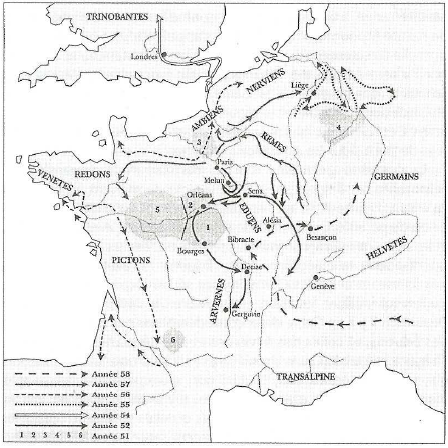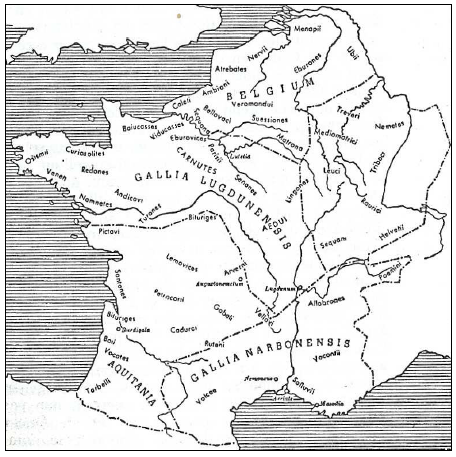C) The Gallo-Roman and Romano-British Periods
In 125 BC, the Romans annexed the Mediterranean coast and named it the Provincia.29 The rest of the territory, designated by the Romans as Gallia Comata or ‘Long-Haired Gaul’, remained Celtic and the La Tène culture flourished until the conquest of Gaul undertaken by Julius Caesar from 58 to 51 BC (fig. 6).30 After the defeat of Vercingetorix in 52 BC at Alésia (Côte d’Or), which marked the beginning of the Gallo-Roman civilization, the Provincia was renamed Narbonnensis, and the Gallia Comata became a Roman province and was divided into three territories: Lyonnaise, Aquitaine and Belgica (fig. 7). As regards Britain, Caesar’s attempts to invade the isle in 55 BC and 54 BC were unsuccessful. Celtic culture endured until the mid-1st c. AD, when, in 43 AD, the Emperor Claudius subdued the Britons and created the Roman province of Britannia.31
The Roman conquest of Gaul and Britain was facilitated by the political and military disunity of the Celtic tribes, who regularly fought among themselves. The quarrel between the Aedui and the Sequani, which triggered the Gallic Wars, is a good example of the instability prevailing within the Celtic communities. After the Sequani - allied with the Arverni and the Germanic mercenaries of Ariovistus - invaded their territory, the Aedui sent their chief Diviciacos to Rome in 61 BC to ask for assistance. In 58 BC, Roman legions were stationed in modern-day Alsace and defeated Ariovistus. Similarly, in Britain, some tribes revolted against the Roman invasion, such as the Iceni and their Queen Boudicca in 60 AD, while others, such as the Brigantes, led by Queen Cartimandua, allied with Rome. Caratacos, the king of the Atrebates tribe, who led the revolt of the Britons against the Roman invasion from 43 AD to 49 AD, took refuge in the Brigantes kingdom, but was betrayed by Queen Cartimandua and handed over to the Romans.32


After the defeat of Gaul and Britain, roads were built for commercial purposes and the ancient territories of the Celtic tribes were transformed into civitates* or ‘cities’, where the Roman political, administrative, commercial and religious values were embraced by the newly Romanized aristocracy – for example the Allobroges’ territory became the city of Vienne, and the Volcae Tectosages’ territory the city of Toulouse.33Each civitas* had a county town and was subdivided into rural districts, called pagi*, and secondary towns, called vici*. Juridically speaking, there were three different types of civitates*: Roman coloniae, inhabited by Roman citizens only; Latin coloniae, composed of Roman and Latin citizens, who had an intermediary status between full Roman citizenship and non-citizen status; and peregrine cities, constituted of people who had neither the Roman citizenship nor the Latin Right*. Gaulish and British warriors placed themselves in the service of Rome, integrated the Roman army and were given Roman citizenship and the functions of command.34 Recruitment was later extended to Romanized peregrines (non-Roman citizens), aged between sixteen and twenty-six, who obtained Roman citizenship as a reward for their incorporation.35
As regards religion, the ancient cults and beliefs of the Celts were not proscribed by Rome, but the druidic sacerdotal function and sacrifices were banned. Since the Celts did not use writing, ancestral beliefs, traditions and myths died out with the disappearance of the druids, who were the holders of the sacred knowledge. The cult of the Roman deities and of the Emperor imposed by Rome in the civitates* significantly influenced Celtic religious life, but the Britons and Gauls did not renounce their culture and religious beliefs for all that. Despite Romanization, Celtic deities went on being prayed to, worshipped and honoured. In other words, British and Gaulish peoples accepted the administrative, political and religious framework of the Romans, while remaining attached to their original way of life, customs and religious practices. This mutual assent led to a complete syncretism between the two religions and gave birth to a new type of religion referred to by researchers as ‘Gallo-Roman’ and ‘Romano-British religion’. The indigenous deities were subjected to what Tacitus calls the interpretatio Romana, a habit which consisted in giving Latin names to gods who did not belong to the Roman pantheon.36 Subsequently, the indigenous gods, who were profoundly different in nature and functions from the Roman gods, undeniably lost a part of their original essence and characteristics in this forced equation. Through this fusion, three modes of worship emerged in the epigraphy. Some of the Celtic deities were entirely replaced by Roman deities (Apollo, Mercury, Mars, Minerva, Maia, etc), and definitely lost their name and identity. Others became epithets of Roman gods or had their name juxtaposed to those of Roman deities, such as Belisama Minerva, Brigantia Victory, and Abnoba Diana. Finally, others were not equated with Roman gods and kept their indigenous name. Such is the case of Damona, Segeta, Segomanna, Bergusia, Rosmerta, Nantosuelta, etc. Within this category, it is interesting to note that some were coupled with Celtic gods, for example Bergusia and Ucuetis, Nantosuelta and Sucellus or Damona and Borvo, while others were partnered with Roman gods, for example Rosmerta and Mercury.